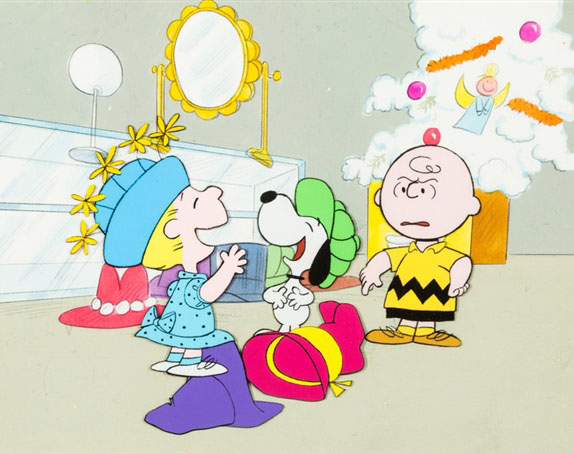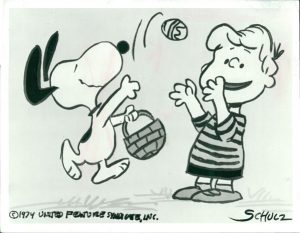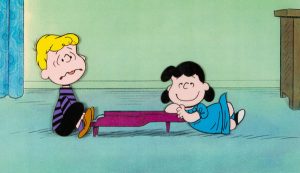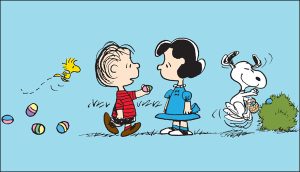
There’s a scene toward the end of It’s The Easter Beagle, Charlie Brown, where Peppermint Patty says, “I’ve seen this happen on holidays before. You look forward to being real happy, and then something happens that spoils it all.” She’s not only speaking for herself and most of the characters in the special but also for the audience watching it at home.
 When It’s The Easter Beagle, Charlie Brown aired in 1974, Charles Schulz’s beloved comic strip Peanuts had left its indelible impression on Christmas, Halloween, and Thanksgiving. As in those other holidays in the world of Charlie Brown and company, there was no doubt that Easter also wouldn’t be perfect, but perfect messages would be expressed.
When It’s The Easter Beagle, Charlie Brown aired in 1974, Charles Schulz’s beloved comic strip Peanuts had left its indelible impression on Christmas, Halloween, and Thanksgiving. As in those other holidays in the world of Charlie Brown and company, there was no doubt that Easter also wouldn’t be perfect, but perfect messages would be expressed.
Like many Peanuts specials, It’s The Easter Beagle, Charlie Brown, celebrating its 50th anniversary this spring, found its inspiration in Schulz’s comic panels, where Snoopy had appeared as the Easter Beagle several years prior.
In the documentary Full Bloom: Peanuts at Easter, the special’s executive producer Lee Mendelson remembered: “The way we created Easter Beagle was similar to the way we created all 45 specials and the series we did later on. Once we picked the topic, in this case, it was Easter and the Easter Beagle, Bill Melendez, the animator, and I would meet with ‘Sparky’ Schulz, and we’d start out, first, thinking about the comic strips that had already dealt with it, and if they could be a basis for the show, or how we could expand from the comics.”
It’s The Easter Beagle, Charlie Brown opens with a unique, humorous, Peanuts-esque take on coloring Easter eggs. Marcie arrives at Peppermint Patty’s house for the tradition of dying the eggs, but instead of hard-boiling them, Marcie fries the eggs. This gag continues throughout the special as Marcie continually misunderstands, later putting the eggs in a waffle iron, toaster, and oven and, when finally, about to boil them, cracks them open into the water.
 Meanwhile, Charlie Brown, Sally, Linus, and Lucy are heading to the store. Sally needs new shoes, and Lucy needs to buy eggs and Easter baskets. Returning to some “Great Pumpkin”-like personal beliefs, Linus tells his sister not to bother, announcing that the “Easter Beagle” will arrive on Easter Sunday and bring everything. To this, Sally replies cynically, “That sounds faintly familiar.”
Meanwhile, Charlie Brown, Sally, Linus, and Lucy are heading to the store. Sally needs new shoes, and Lucy needs to buy eggs and Easter baskets. Returning to some “Great Pumpkin”-like personal beliefs, Linus tells his sister not to bother, announcing that the “Easter Beagle” will arrive on Easter Sunday and bring everything. To this, Sally replies cynically, “That sounds faintly familiar.”
Charlie Brown and the gang head out to the store and meet with Peppermint Patty and Marcie. As they make their way through the large superstore, there are not-so-subtle comments on the commercialism of the holidays. Except here, much like A Charlie Brown Christmas, the yuletide season is in the satirical spotlight.
Signs are plastered everywhere, announcing that the store’s Christmas sale is already happening – “Only 246 Days Until Christmas!” – while gaudy Christmas trees and decorations are splashed everywhere.
 While in the store, Snoopy looks inside a panoramic Easter egg, at an Easter scene filled with bunnies and then imagines himself dancing with them against a very springtime background in a moment of fanciful animation.
While in the store, Snoopy looks inside a panoramic Easter egg, at an Easter scene filled with bunnies and then imagines himself dancing with them against a very springtime background in a moment of fanciful animation.
There’s another subplot in Easter Beagle, during which Snoopy assists Woodstock with moving into a new birdhouse, which is decked out as an oh-so-70s bachelor pad, complete with a recliner, psychedelic posters on the wall and a (then) state-of-the-art stereo system.
Meanwhile, Lucy decides that she is going to hide all of the eggs for the Easter egg hunt. “Easter is very simple,” she says. “You paint the eggs. You hide the eggs. And, you find the eggs. And you know who is going to find the eggs? Me! Because I’m the one who is going to hide them!” However, Snoopy follows and snatches each egg as Lucy hides it.
It all culminates on Easter morning, when Linus finally gets a reprise for the Great Pumpkin, as The Easter Beagle (Snoopy) makes his appearance, dancing through the neighborhood with his basket, giving out all of Lucy’s eggs to everyone (except poor Charlie Brown, of course).
 Marcie finally seems to grasp Easter eggs, understanding that once you receive one, you can sprinkle it with salt and eat it, which she does…shell and all.
Marcie finally seems to grasp Easter eggs, understanding that once you receive one, you can sprinkle it with salt and eat it, which she does…shell and all.
As the special ends, it’s ten weeks after Easter, and Lucy is still angry at Snoopy for swiping all of her eggs. She decides to go out to his doghouse and confront him, but Snoopy kisses Lucy, providing a happy holiday ending.
In addition to Charles Schulz’s humor and perspective, It’s The Easter Beagle, Charlie Brown works so well because all of the same talents who brought us the other classic specials were involved.
 In addition to Mendelson and Melendez as executive producer and producer, respectively, Phil Roman, who directed several other popular Peanuts specials, including those for Thanksgiving and Valentine’s Day, was at the helm for Easter Beagle.
In addition to Mendelson and Melendez as executive producer and producer, respectively, Phil Roman, who directed several other popular Peanuts specials, including those for Thanksgiving and Valentine’s Day, was at the helm for Easter Beagle.
The special’s animation team, including legends such as Don Lusk and Bill Littlejohn, brought life and personality to a number of sequences, including those humorous pantomime moments between Snoopy and Woodstock.
Easter Beagle’s design team, Evert Brown, Bernard Gruver, Frank Smith, and Dean Spille, brought bright and lovely springtime colors to all the backgrounds, particularly the sequence involving Snoopy’s spirited dance with the bunnies.
Weaving through all of this is the usual, comforting jazz score by Vince Guaraldi, who created iconic music for a number of the Peanuts specials and, in Easter Beagle, also laces in lilting music that’s perfect for spring.
Originally airing on CBS on April 9, 1974, It’s The Easter Beagle, Charlie Brown continued to air on CBS for every Easter season through 2000. It also earned an Emmy Nomination for Outstanding Children’s Special.
 The special moved to ABC from 2001 through 2006. When the special aired again in 2008, thirty-four years after its debut, It’s The Easter Beagle, Charlie Brown came in fourth place in the ratings, behind such hit shows as American Idol, NCIS, and The Biggest Loser.
The special moved to ABC from 2001 through 2006. When the special aired again in 2008, thirty-four years after its debut, It’s The Easter Beagle, Charlie Brown came in fourth place in the ratings, behind such hit shows as American Idol, NCIS, and The Biggest Loser.
It was more proof of the special’s enduring appeal and how, fifty years later, it has become linked to the holiday it celebrated, like so many other Peanuts TV specials.
Mendelson attributed the popularity of It’s The Easter Beagle, Charlie Brown to the enduring appeal and relatability of all of Charles Schulz’s work: “There’s always a new generation coming along that is struggling with the painting of the eggs, or whatever holiday happens to be there. And, I think that’s why it’s remained one of our most popular shows.”


 Michael Lyons is a freelance writer, specializing in film, television, and pop culture. He is the author of the book, Drawn to Greatness: Disney’s Animation Renaissance, which chronicles the amazing growth at the Disney animation studio in the 1990s. In addition to Animation Scoop and Cartoon Research, he has contributed to Remind Magazine, Cinefantastique, Animation World Network and Disney Magazine. He also writes a blog, Screen Saver: A Retro Review of TV Shows and Movies of Yesteryear and his interviews with a number of animation legends have been featured in several volumes of the books, Walt’s People. You can visit Michael’s web site Words From Lyons at:
Michael Lyons is a freelance writer, specializing in film, television, and pop culture. He is the author of the book, Drawn to Greatness: Disney’s Animation Renaissance, which chronicles the amazing growth at the Disney animation studio in the 1990s. In addition to Animation Scoop and Cartoon Research, he has contributed to Remind Magazine, Cinefantastique, Animation World Network and Disney Magazine. He also writes a blog, Screen Saver: A Retro Review of TV Shows and Movies of Yesteryear and his interviews with a number of animation legends have been featured in several volumes of the books, Walt’s People. You can visit Michael’s web site Words From Lyons at: 






















In the original Christmas special, Linus recounted the story of Christ’s Nativity from the Gospel according to Luke as being “what Christmas is all about.” Here, however, he has nothing at all to say about the Resurrection. Instead, he’s gone full-on pagan, fabricating another holiday idol to join the Great Pumpkin in the Peanuts pantheon. I wonder if his familiarity with scripture extends to knowing what Deuteronomy says about false prophets (hint: it’s not “turn the other cheek”). Sally and Snoopy ought to be grateful that Linus had no apparent plans to sacrifice children and animals to the spring gods, as was the custom in pagan times.
Another notable contributor to “It’s the Easter Beagle, Charlie Brown” was Schroeder’s good friend Ludwig van Beethoven, who generously waived all royalties for the use of his Symphony No. 7 in A major, Opus 92. Offers to give the composer at least a screen credit fell on deaf ears.
When Charlie Brown and his friends are taking the UP escalator in the department store, there is a man in a red cap taking the DOWN escalator at the same time. It’s not a drawing, but a photograph of an actual person. WHO IS HE??? Fifty years of this unexplained in-joke is too long.
“A Charlie Brown Thanksgiving” also had a scene with Linus talking about the first Thanksgiving and saying a prayer. I never noticed that there was no religious message in “Easter Beagle” until you pointed it out. Considering how religious Schulz was, this is surprising.
That escalator scene was a silly edit made by someone in recent years, it’s in no way part of the actual special.
As in the “Great Pumpkin” special, the manifestation of Linus’ fantasy is realized by Snoopy–but with a difference. In “ITGPCB” Linus and Snoopy are working at cross purposes–each dwelling within the scope of his own fantasy world–Linus believing heart and soul in the Great Pumpkin while at the same time leaving himself a loophole in case his prediction does not come true, namely that the GP will only appear in an atmosphere of pure belief and sincerity–and Snoopy carrying out his own scenario as a downed WWI flying ace making his way across France. When these two plots meet, they only briefly intertwine. Linus believes that the flying ace Snoopy is the Great Pumpkin, and it is Sally who disabuses him of the notion, pointing out in her practical way that all they saw in the pumpkin patch was “a stupid beagle.” Because Linus and Snoopy are working in different scenarios, their dreams do not mesh perfectly. By the next morning, Snoopy has gone back to being an ordinary (but we know better) dog, and Linus to being an ordinary (but we know better) youngster.
It all plays out differently in Easter Beagle. This time, by the very name of. Linus’ alternate take on the Easter Bunny, Snoopy has already been incorporated into his dream, and on this occasion there is collusion of sorts–even if not consciously planned or schemed–between the two. Whether consciously or subconsciously, there is a meeting of minds between these two fantasists–a tacit agreement that Snoopy will fulfill the prophecies of Linus. Thus, Snoopy engineers his role with precision, looking for the perfect opportunity to avail himself of a ready-made supply of Easter eggs provided all unawares by Lucy, who does not realize until the end that she is but an instrument in the grand scheme concocted between Linus and Snoopy. Because ultimately what occurs is a con game, instigated by Linus and carried out by Snoopy, the ultimate fulfillment of which occurs when Linus’ prophecies are proven true. From a story point of view, it doesn’t matter whether Linus and Snoopy are working out a prior agreement or if Snoopy is independently taking on his role in order to manifest Linus’ predictions–or if his Easter Beagle persona is being enacted coincidentally without deliberate connivance, either real or imagined, with Linus. Because, coincidence or not, the two work in concert to bring about the “miracle/con” of the ending scenes.
Timing is everything. Just as the disciples of Jesus were in despair on that first Easter morning, their hopelessness soon to be washed away by the miracle of the Resurrection, so too the hopes of our Peanuts protagonists, all of which have apparently been dashed, are restored when for once a prediction of Linus proves prophetic. The Easter Beagle may be a con game, but it is meticulously timed to have the greatest impact, and to bring about the closest thing to a “happy ending” that is possible in the Peanuts world. Thus the collaboration of Snoopy and Linus works to everyone’s advantage–even ultimately to Lucy’s.
For Lucy’s reaction to Snoopy’s kiss justifies the con game that has gone before. Instead of her usual reaction to “dog germs”, Lucy gives in to the charms of the Easter Beagle and thus through her blissful reaction, resolves the whole plot.
When viewed as a counterpoint to “Great Pumpkin,” the “Easter Beagle” story ultimately proves to be a flip-flop of the earlier special. It becomes a tale of restoration and reconciliation, of hopes dashed and hopes recovered, of prophecies fulfilled, even of atonement and forgiveness. And are these themes not precisely what Easter is all about?
I would like to add that I neglected to mention about poor Charlie Brown, who doesn’t quite get the happy ending enjoyed by the others, because true to form the Easter Beagle runs out of eggs by the time it is his turn. So not everyone ends blissfully.
Also–and this is very important–my references to a “con game” are with regard to the plot of this TV special, and in no way are meant aa a reflection on the Easter story as elaborated in the Gospels. As a pastor in a small church, I myself believe the Scriptures are authentic. I do not for one minute believe that there is any “con game” associated with the Gospel accounts. Which is why Lucy’s forgiveness of Linus and Snoopy’s deception (and theft) is so crucial to the resolution of the plot. And as in the Gospel accounts, forgiveness and love are the order of the day, with the difference being that where the “miracle” concocted by Linus and Snoopy is a contrivance, the Resurrection was and is (according to my theology) genuine.
Two counts against “Easter Beagle” that keep it out of the “Charlie Brown Christmas”/”Great Pumpkin” class. It’s out of character, and not funny, for Marcie, Peppermint Patty’s Alice B. Toklas-like sidekick, to be that stupid regarding the preparation of Easter eggs (hard boiled is not a difficult concept). The store with its Christmas decorations up already, or maybe they never took them down after December, detracts from the show being about Easter; Snoopy’s dance with Peppermint Patty and Marcie (a highlight) eclipses his imagined dance with the bunnies.
Actually, the show’s worse flaw is its superficial, perfunctory take on the holiday itself. Linus quoting Scripture already had been done, and jelly beans had been part of Charlie Brown’s improvised Thanksgiving feast; but there’s no sense of celebration of rebirth and renewal central to the day. The title could have been “Your Heart’s Not Really In This One, Charlie Brown.”
Geez, I thought the Marcie sub-plot was quite memorable. And jellybeans are EVERYWHERE during Easter. The stores sell them like crazy during this time. It’s not a reprise of the Thanksgiving special.
I’m with you. The Valentines special, airing the following year, is far stronger and more poignant. The one thing that really elevates Easter Beagle is Littlejohn’s animation.
I loved Woodstock’s bachelor pad. However, I always fixate on the fact that when Snoopy demolishes the pad and all the broken wood is lying on the ground, there is no sign of the home’s groovy furniture and paintings anywhere to be found.
I notice the same thing. Unless we are to assume that the furniture was all a dream of Woodstock’s?
For those that considered this special “uninspired”, I say wait till the next decade when you’re watching the likes of Someday You’ll Find Her… and It’s Flashbeagle…–It’ll come off like a masterpiece by comparison.
There’s some bits here and there I get a kick out of–The store’s pre-pre-pre-Christmas promotion is another example of Sparky’s ahead-of-the-curve satire, as anyone who listens to bitching and whining each year over yuletide paraphernalia being stocked in the Fall months will attest. And Sally leaving an entire chapeau display on the floor will strike a chord in anyone who’s worked retail.
Then there’s the usual fun of waiting for the repeat animation scenes (make it a drinking game!), listening to Guaraldi’s jazz keyboard noodling (sad to think he’d be gone in two years), and you’ve got a pleasant, if not particularly memorable, half-hour. I miss the days of excitedly looking forward to a new Peanuts program.
Feelings about Flashbeagle, like many things, tend to be affected by age. As a millennial I’m quite fond of it, and I believe I’m not alone in my generation (and I believe we are joined by some of the younger GenXers). I think the Snoopy-mad youngsters on TikTok etc. are also pretty keen. Wherever you stand on it, it’s certainly not the most forgettable entry.
It seems every schlocky cartoon from the Seventies and Eighties has a fanbase, so I’m certainly not surprised “Flashbeagle” has some sort of following. Doesn’t change the fact, however, that it’s a vapid, soulless entry in the franchise, existing only to sell ancillary merch such as an accompanying soundtrack album and aerobic Snoopy plush dolls. Not Schulz’ finest (half) hour by any means, though you are right that it’s not quite rock-bottom–That honor goes to the Super Bowl special.
I happen to like that Super Bowl special. And for the record, “Flash Beagle” originated as a one-strip gag in the comic.
“Flashbeagle? I can’t stand it!” — Charlie Brown
Actually, Frank Smith also animated a scene in this as well. The scene where Lucy and Linus were hiding the eggs while Snoopy takes them. Frank was actually one of the really great animators on the specials. He animates the characters really on model and nice, and can make them do simple actions pretty well. He also follows the animation principle of Arcs really nicely with the movement (like the character acting and walking). He did scenes like the opening of Great Pumpkin, the kite making scene from A Boy Named Charlie Brown, and the psychiatric scene from the Christmas one. This was the last special he worked on before he died in 1975. In a way he was THE Peanuts animator and the specials lost a big part of what they were when he passed.
By Frank doing the design, I think they meant the character model sheets of the characters. It certainly looks like his way of drawing them. Again, he was really good at drawing the kids, so this makes sense.
I feel like the familiar charm of other Peanuts specials was definitely present in this one. However, it seems to have lacked the depth that was displayed in other holiday specials as it felt there were a few missed opportunities, but still enjoyable.
Hope you all had a wonderful Easter!